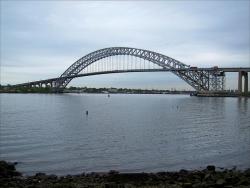USA


Soon after gold was discovered at Sutter's Mill near Sacramento in 1848, General John Bidwell found gold near the Middle Fork of the Feather River. His discovery brought hordes of miners to the scene and Bidwell Bar was born. The Bidwell Bar Suspension Bridge over the Feather River was one of several suspension bridges built in the region in the 1850s, and is the only one that remains.

The first known pumping system providing drinking and wash water in the North American colonies. The building (still standing) is dated 1761, but it was preceded by an experimental frame building dated 1754. Before the Bethlehem built its system, assigned carriers would daily haul water up the hill from a well near the city gate. A wooden waterwheel, driven by the flow of Monocacy Creek, drove wooden pumps which lifted the water through wooden pipes to the top of the hill where the water was distributed by gravity.

The St. Petersburg Yacht Basin was the original operating location of the St. Petersburg – Tampa Airboat Line, the nation’s first, regularly-scheduled commercial airline. The line’s inaugural flight was on January 1, 1914, with two daily, round-trip flights between St. Petersburg, Fla., and Tampa, Fla., using two Benoist Type XIV airboats. The flights were twenty-two minutes in length, one way, and rarely exceeded an altitude of five feet above the waters of Tampa Bay.

Belle Fourche, meaning "Beautiful Forks" in French, refers to the confluence of the Redwater and Belle Fourche Rivers. The gold rush to the Black Hills in 1876 brought many people to the area, but agriculture and livestock soon became the principal industries. Farmers and civic leaders recognized the need for a reliable source of irrigation water in this semi-arid region and petitioned the Federal government for funds to build an irrigation and flood control system.


Montogomery Bell was a land developer and iron maker who purchased the Harpeth Narrows site to expand his industrial empire - which ultimately consisted of 14 iron blast furnaces throughout middle Tennessee.
The Harpeth River makes a tight bend around a steep limestone ridge, losing 17 feet of elevation in a run of 5 1/2 miles. Bell excavated a tunnel through the limestone ridge, creating a shortcut for the river. The hydropower derived from this drop in elevation was used to drive the Patterson Iron Works built by Bell.

The longest steel-arch bridge in the world for 46 years, the Bayonne Bridge continues to be celebrated today as a major aesthetic and technical achievement. The 1,675-foot bridge replaced a ferry service which until then was the only means of crossing from the Bayonne peninsula to Staten Island. While providing this essential link in the transportation network of greater New York City, the bridge's mid-span clearance of 150 feet also allows for unobstructed navigation on Newark Bay, the main shipping channel to the inland ports of Newark and Elizabeth, New Jersey.

Built by the Bay City Dredge Works of Bay City, Michigan, this dredge was used to construct a portion of US 41 called the Tamiami Trail, which connected Tampa with Miami through the Everglades and Big Cypress Swamp. The last remaining display of walking dredges (of some 145 walking machines), it has a unique propulsion design enabling the dredge to cope with drainage problems in a wetlands environment.



